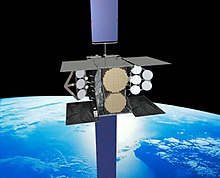Wideband Global SATCOM
The Wideband Global SATCOM (until 2007 Wideband Gapfiller Satellite System, WGS ) is a military satellite communication system of the US Department of Defense .
The system consists of three segments:
- the satellites that make up the space segment ,
- the communication terminals of the users, referred to as Terminal Segment , and
- the control segment , the ground control of the satellites.
The WGS system will complement and later replace the armed forces' current broadband communications services, consisting of the Defense Satellite Communications System (DSCS) and Global Broadcast System (GBS). According to the military project managers, a single WGS satellite has the same transmission bandwidth as the entire DSCS-III satellite constellation.
Satellites
The about 6000 kg satellites from Boeing Satellite Systems based on the BSS 702 - satellite model built. They were brought into geostationary orbit from Cape Canaveral Air Force Station using Atlas V and Delta IV rockets and are designed for a service life of 14 years. According to the Air Force Space Command in 2008, each of the satellites cost about 300 million US dollars .
The payload consists of an X- and Ka-band communication device that can be switched to a total of 19 individually controllable transmission areas. Data transfer rates of up to 3.6 Gbit / s are possible over a bandwidth of 4.875 GHz . The satellites in block 2 have additional broadband transmission capacity for airborne reconnaissance systems. Of the nine satellites in orbit, the sixth was financed by Australia and the ninth jointly by Canada, Denmark, the Netherlands, Luxembourg and New Zealand in exchange for rights to use the WGS system.
Starts
| satellite | logo | Start date ( UTC ) | rocket | comment |
|---|---|---|---|---|
| Block 1 | ||||
| WGS 1 | October 11, 2007 | Atlas-V (421) | success | |
| WGS 2 | April 4, 2009 | Atlas-V (421) | success | |
| WGS 3 | December 5, 2009 | Delta IVM + (5.4) | success | |
| Block 2 | ||||
| WGS 4 | January 20, 2012 | Delta IVM + (5.4) | success | |
| WGS 5 | May 25, 2013 | Delta IVM + (5.4) | success | |
| WGS 6 | August 8, 2013 | Delta IVM + (5.4) | success | |
| WGS 7 | July 24, 2015 | Delta IVM + (5.4) | success | |
| WGS 8 | December 7, 2016 | Delta IVM + (5.4) | success | |
| WGS 9 | 18th March 2017 | Delta IVM + (5.4) | success | |
| WGS 10 | 16th March 2019 | Delta IVM + (5.4) | success | |
| WGS 11 | approx. 2024 | planned | ||
Web links
- LAAFB: Fact Sheet: Wideband Global SATCOM (WGS) (English)
- Gunter's Space Page WGS (English)
Individual evidence
- ↑ a b Wideband Global SATCOM Satellite. US Air Force Space Command, archived from original January 8, 2007 ; accessed on March 25, 2008 (English).
- ^ Environmental Assessment - US Air Force Wideband Gapfiller Satellite Program. (PDF) Defense Technical Information Center, accessed March 25, 2008 .
- ^ Pre-launch ops keep crews busy at the Cape. Spaceflight Now, accessed March 25, 2008 .
- ^ US, Australia formalize Wideband Global SATCOM agreement. Spaceflight Now, November 15, 2007, accessed March 25, 2008 .
- ↑ Boeing to Build More Wideband Global SATCOM Satellites for US Air Force. Boeing, January 18, 2012, accessed January 20, 2012 .
- ^ Jared Haworth: Breaking Barriers: The launch of WGS-9. In: wereportspace.com. March 19, 2017. Retrieved March 25, 2017 .
- ↑ Delta 4 rocket soars on Defense Department mission. Spaceflight Now, January 20, 2012, accessed January 20, 2012 .
- ↑ United Launch Alliance: Delta IV to Launch WGS-9 for the US Air Force. March 16, 2017, accessed March 17, 2017 .
- ↑ Contracts for April 19, 2019. Department of Defense, April 19, 2019, accessed April 20, 2019 .








